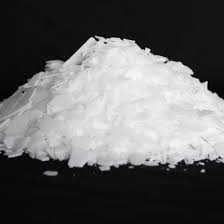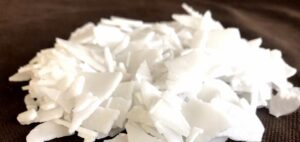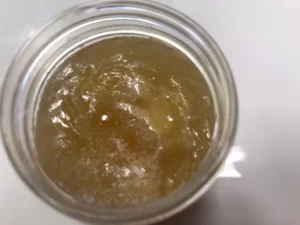Polyethylene wax is distinguished by its excellent resistance to moisture, chemicals, and abrasion. These features make it a highly sought-after material in diverse industries. You can find it playing crucial roles in enhancing the quality and performance of products ranging from inks and coatings to plastics and cosmetics.
The global market for polyethylene wax has been witnessing significant growth, driven by its expanding applications and the continual innovation in its production techniques. This growth trend reflects the material’s adaptability and its ability to meet the ever-evolving demands of modern manufacturing.
For professionals and enthusiasts alike, gaining an understanding of PE wax not only opens a window into its vast applications but also into future trends and advancements in the manufacturing sector.
Chemical Compound and Production Process
Polyethylene wax, a unique synthetic material, originates from ethylene, a fundamental building block in the petrochemical industry. The production process of PE wax involves polymerizing ethylene, a method that allows control over the molecular weight and structure of the resulting wax. This process, which you can observe in various forms such as cracking or polymerizing, results in a product with distinctive properties like low viscosity and high softening points.
Polyethylene wax has different characteristics depending on its density. For instance, high-density PE wax offers greater hardness and melting points which is ideal for specific applications. Understanding these production subtleties can be crucial if you are involved in industries where PE wax’s properties are critical.
Applications in Manufacturing
Polyethylene wax’s unique properties make it a valuable asset across various manufacturing industries. Below you can find examples from different industries.
Coatings and Paints Industry
PE wax serves as an invaluable additive in the coatings and paints industry. It improves the resistance of paints and coatings against scuff, abrasion, and chemicals, thereby extending the life and appearance of painted surfaces.
For example; PE wax is used in automotive coatings to provide a protective, glossy finish that withstands environmental stress.
Ink Industry
PE wax plays a crucial role in the formulation of printing inks. It enhances the slip properties and rub resistance, ensuring high-quality print results.
For example; in flexographic and lithographic inks, PE wax additives contribute to smoother print finishes and prevent set-off in stacked printed materials.
Plastics Industry
In plastics manufacturing, PE wax is utilized as a lubricant and processing aid. It facilitates smoother processing and enhances the flow of plastic materials in extrusion and injection molding processes.
For example; in PVC pipe manufacturing, PE wax is added to improve the processing efficiency and surface quality of the pipes.
Cosmetics and Personal Care Industry
The cosmetics sector employs PE wax in a variety of products, owing to its texture-enhancing properties. It helps in stabilizing emulsions and improving the consistency of cosmetic products.
For example; PE wax is used in lipsticks and moisturizing creams to improve texture and longevity.
Adhesives Industry
In adhesives production, We use PE wax to adjust the tack and set time. It provides a balance between adhesive strength and ease of application.
For example; hot melt adhesives incorporate PE wax to control open time and solidification rate, ensuring effective bonding on various surfaces.
Rubber Industry
We utilize PE wax in the rubber industry as a processing aid and release agent. It enhances the flow of rubber compounds and prevents adhesion during the molding process.
For example; in tire manufacturing, PE wax helps in releasing the tires from molds while also providing a protective barrier against ozone and UV degradation.
Printing Industry (Color Toners)
In the production of color toners for laser printers, PE wax contributes to the toner’s performance by improving chargeability and flow characteristics.
For example; high-quality color laser printing uses PE wax-infused toners for vibrant and long-lasting print results.
Candle Industry
Though less common, PE wax finds its application in the candle industry. We use that to modify the properties of paraffin wax, improving the burning quality and stability of candles.
For example; specialty candles incorporate PE wax to achieve specific melting points and burning characteristics.
Pros and Cons of PE Wax
PE wax offers excellent thermal stability, low toxicity, and compatibility with a wide range of materials. These properties make it a safe and effective choice in various applications. You can see below the advantages and disadvantages of polyethylene wax.
Pros
- PE wax acts as a lubricant, facilitating smoother processing and reducing energy consumption.
- PE wax imparts superior qualities to products across various industries. For instance, it enhances the gloss and durability of coatings in the paint industry.
- The diverse applications of polyethylene wax, from additives for inks to cosmetics productions, highlight its versatility. We formulate that to meet specific industry needs.
- Generally considered safe for the environment, PE wax in its standard form does not pose significant ecological risks, making it a preferable choice in the polyethylene wax market.
- PE wax exhibits excellent thermal stability, making it suitable for applications that involve high-temperature processes, like color toner manufacturing.
Cons
- Depending on its formulation, PE wax might not be compatible with certain polymers or substances, which can be a limitation in some manufacturing processes.
- While PE wax itself is safe, issues can arise with its disposal. Proper disposal methods we require to prevent any potential environmental impact.
- However, The cost of PE wax can fluctuate based on market conditions, impacting industries like adhesives and cosmetics productions where budget constraints are a concern.
- In certain specialized applications, the properties of PE wax might not fully meet the requirements, necessitating the use of alternative materials or additives.
- As with many chemical compounds used in manufacturing, navigating the regulatory landscape for PE wax can be challenging, particularly in industries like dispersants of pigments and plastics production.
FAQ
What are the different types of polyethylene wax?
- However, Polyethylene wax comes in various forms, each suited for specific applications. These include high-density, low-density, oxidized, and polymerized PE wax. The choice depends on factors like hardness, melting point, and compatibility with other materials.
How big is the polyethylene wax market?
- Meanwhile, The polyethylene wax market is a substantial segment within the specialty chemicals industry. Its growth is driven by its widespread use in numerous applications, from coatings and plastics to cosmetics and adhesives.
What is the difference between oxidized PE wax and PE wax?
- Oxidized polyethylene wax (oxidized PE wax) differs from standard polyethylene wax (PE wax) due to the presence of hydroxyl groups in its molecular structure. These hydroxyl groups enhance the miscibility of oxidized PE wax with polar resins, making it more effective when used with polar materials. As a result, oxidized PE wax offers improved performance over standard PE wax in applications involving polar substances.



